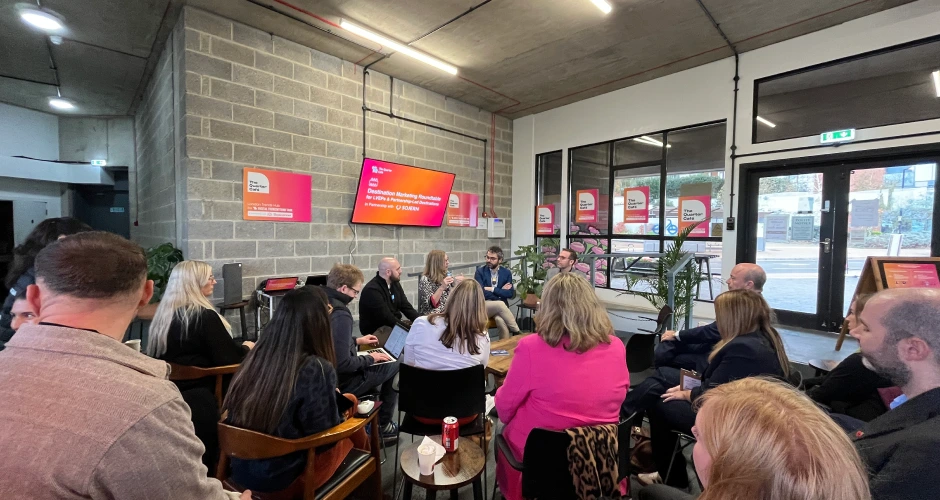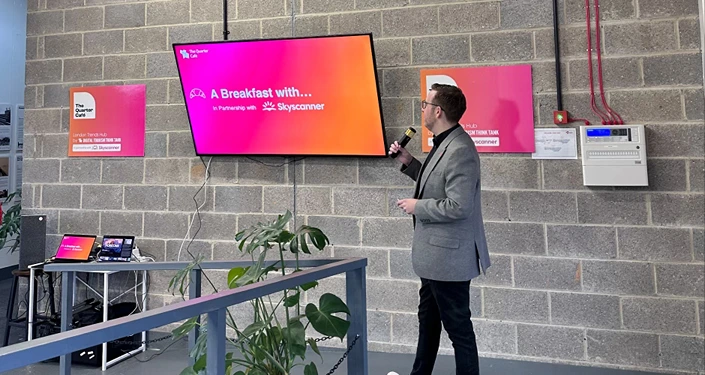In episode 5 of our "Tour Tech: Your 5 Weekly Takeaways to Tourism Success" podcast series, part of the EU-funded Tourbit project, we learn about how digitalisation can improve customer relationship management processes. This article explores how Avidly Agency, a HubSpot service provider, and Kemi Tourism work together to fully leverage the capabilities of technology to optimise operations and foster collaboration.
Responding to Pandemic Challenges
Kemi Tourism, like the majority of tourism businesses, found itself struggling after the COVID-19 pandemic, with over 70% of turnover generated during the winter season. The company operates Arctic icebreaking cruises on the ship Sampo, with visitors arriving from more than 50 countries since its launch in the 1980s. Another important product is the SnowCastle, which was first constructed in the 1990s. The company also manages international sales for the wider region (called Sea Lapland).
Jaakko Löppönen, CEO of Kemi Tourism highlights that their traditional sales processes, which relied heavily on manual pen and paper methods, proved to be inefficient in the face of a changing market. COVID-19 resulted in the loss of a substantial portion of their regular customers. However, such a situation provided the necessary impetus for change, with the organisation strategising around how to recover tourism volumes.
The Decision to Digitalise
Kemi Tourism recognised the need to adapt and embrace digitalisation as a means of overcoming challenges. Jaakko emphasises that this transformation isn’t a quick fix, but rather a long-term strategy. Juha Sorjonen, Account Director at Avidly, sets out the steps for the cooperation between the two companies, starting with the establishment of a wider perspective to understand acute needs and identify realistic objectives for Kemi Tourism. Redesigning the whole operational model means a key focus becomes gathering and understanding customer data to understand the diverse needs of different markets, a crucial element for success in the digital age.
In contrast to companies that prioritise marketing, Juha outlines the priority to achieve sales-driven operations, enabling fast results given the dynamic environment and Kemi Tourism’s primarily B2B sales channels. Jaakko reiterates that Kemi Tourism’s priority is to understand its current sales process to determine whether HubSpot could be the tool to put all internal business intelligence together in a digital form, leveraging Avidly’s expertise in using the platform to build resiliency and ensure that successful sales processes can be regularly repeated. This is particularly significant given the need to provide consistent service and maintain long-term relationships despite employee changes. Even more important is the need to take a longer-term view and consider the potential longevity of the platform to ensure continued relevancy as the company evolves and then continue to enhance the platform.
Transforming Operations By Using a CRM
Juha explains that HubSpot is a leading marketing technology platform ecosystem, supporting the sales pipeline, effective customer service and marketing, with data management at the core. With information scattered across all visitor touchpoints, data needs to be shared through a centralised platform to eliminate silos and ensure effective collaboration between employees from all departments. Through the integration of third-party tools, HubSpot’s capabilities lead to significant improvements in several areas:
- Streamlined Sales Operations: A digital sales process allows for faster lead conversion and improved efficiency, minimising lost sales from international clients in different time zones.
- Enhanced Customer Relationship Management (CRM): HubSpot's CRM functionalities consolidate customer data into a central location, facilitating the segmentation of different buyers to help determine the priorities for building relationships with new leads.
- Improved Communication: With Kemi Tourism’s globally dispersed customer base, clear and consistent communication is essential. HubSpot's tools enable smoother interaction and engagement to respond faster to any reservation modification.
Lots of experimentation is needed to find the most effective methods for using HubSpot and streamlining operations. However, Juha emphasises the importance of two-way communication to make the process as simple as possible for the least-enabled customer, adapting to changes in their operating environments.
Enabling Employees
The process of digital transformation presents its own set of hurdles, particularly in terms of human resources. People are the cornerstone of businesses and fluid digital tools enable them to maximise individual and team performance, ultimately helping companies to place more attention in the long-term on improving the central aspect of their competitive edge; the product. Encouraging employees to adopt new tools and workflows requires effective change management strategies that enable staff to understand the rationale for using a new tech-driven approach and effectively train them to use the platform. Due to the unified way of using HubSpot for data sharing, one problem will cause the whole system to fail. This necessitates a thorough understanding of how different departments use the platform to minimise risks and a strong focus on quality control.
Additionally, Jaakko highlights that while digital technologies excite people during the initial roll-out, people will at various points see it as a burden. To combat this, change should be implemented in small steps, with employees challenged to enter this unfamiliar territory, frequently highlighting the benefits of the platform for both employees and the company. Jaakko mentions that by following this phased approach account managers become more committed to the process, sharing their own suggestions for further improving processes.
Towards A More Digital Future
With growing cost structures, Jaakko emphasises growth as being essential to the long-term success of Kemi Tourism. Lead times are between 12 to 24 months, requiring accurate predictions and a clear outlook of how the world will change in that time period.
Kemi Tourism has ambitious plans to continue leveraging digital tools for further growth, with a focus on:
- Expanding Go-to-Market Strategy: Utilising digital channels effectively allows Kemi Tourism to change its approach to risk management, facilitating expansion into new markets. This will reduce dependency on its existing client base through partnering with even more resellers. Meanwhile, Kemi Tourism also aims to deseasonalise its product offering by attracting domestic travellers in the summer season.
- Investing in Personnel: Kemi Tourism understands that moving beyond the processes optimised through HubSpot, there is a need to understand the distribution channels. Recognising that this remit was not in the daily role of its current employees, the company has hired a dedicated digital channel manager to focus specifically on this area.
Key Takeaways for SMEs
Technology enables businesses to improve their operations, with digital systems facilitating the repetition of tasks and minimising disruption due to staff changes. Kemi Tourism's story serves as a valuable case study for SMEs considering digital transformation, effectively demonstrating how through embracing change and investing in the right tools and expertise, businesses can unlock new opportunities for growth in the digital age. Yet, such shifts should always be gradual, with employees receiving support to get used to the new ways of working and ensure that processes are fully functional before transitioning into a new approach.
Organisations should be agile and use digital tools to optimise their processes. Through integrating digital business intelligence systems, information is stored in one location and accessible to the whole company. Instead of working in silos, digital tools enable better collaboration between different departments. Through such systems, businesses gain better data about how to meet the needs of their clients, enabling improved segmentation and targeting based on behaviour.
Digitising customer relationship management systems doesn't just improve company operations but also maximises visitor experiences. Therefore, when deciding on the right system to implement, businesses need a future mindset to take into consideration the planned growth of their company and understand how the world is changing and the evolving purchasing behaviour of their customers. This helps to build resiliency, with digital tools supporting companies, who can then focus on their core competitive edge by investing in product development.
Here are the five key takeaways:
- Customer centricity is key. Understanding and segmenting customer data ensures tailored and impactful interactions.
- The adoption of new tools requires ongoing education and growth support for everyone in the company, meaning entrepreneurs need to always focus on change management within the business.
- Innovative tools can really support sustainable growth for businesses. It’s important to carefully select the right digital tools that can support businesses to scale efficiently, enhance customer satisfaction and plan for growth.
- CRMs allow companies to collect data from different systems and group them into one tool, streamlining data analytics to facilitate the automation of repetitive tasks. This ensures businesses can be smart, agile and ultra-focused on the effective implementation of strategies.
- Regularly questioning business practices fosters a culture of continuous improvement and innovation. In a world that never stops changing, it’s imperative to embrace change and be our own best critic, while also considering external input.
The podcast is part of the Tourbit project, co-funded by the EU's COSME programme, with the support of the Catalan Tourist Board, Barcelona Chamber of Commerce, Paris&Co, Arctur Doo, Hub Brussels, Iceland Tourism Cluster, Lapland University of Applied Sciences and NEST - Tourism Innovation Center.






.svg)









.webp)
